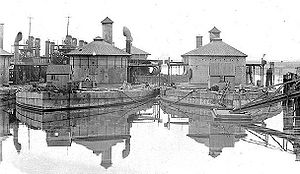USS Montauk (1862)
 USS Montauk (left) alongside USS Lehigh in Philadelphia Navy Yard, circa 1902. | |
| Career | 100x35px |
|---|---|
| Name: | USS Montauk |
| Builder: | Continental Iron Works |
| Launched: | 9 October 1862 |
| Commissioned: | 14 December 1862 |
| Decommissioned: | March 1899 |
| Fate: | sold, 14 April 1904 |
| General characteristics | |
| Type: | Ironclad monitor |
| Displacement: | 750 long tons (760 t) |
| Length: | 200 ft (61 m) o/a |
| Beam: | 46 ft (14 m) |
| Draft: | 10 ft 6 in (3.20 m) |
| Installed power: | 320 ihp (240 kW) |
| Propulsion: |
1 × Ericsson vibrating lever engine 2 × Martin boilers 1 × shaft |
| Speed: | 7 kn (8.1 mph; 13 km/h) |
| Complement: | 75 officers and enlisted |
| Armament: | 1 × 15 in (380 mm) smoothbore, 1 × 11 in (280 mm) smoothbore |
| Armor: |
|
| Notes: | Armor is iron. |
The first USS Montauk was a single-turreted monitor in the United States Navy during the American Civil War.
It saw action throughout the war and was used as the floating prison for the conspirators in the Abraham Lincoln assassination and was the site of the autopsy and identification of assassin John Wilkes Booth.
Montauk (named for Montauk, New York) was built by John Ericsson at Continental Iron Works, Greenpoint, Brooklyn; launched on 9 October 1862; and commissioned at New York on 14 December 1862, Commander John L. Worden in command.
A principal ironclad in the naval attack on Charleston, South Carolina, Montauk departed New York on 24 December 1862, arriving Port Royal on 19 January 1863 to join the South Atlantic Blockading Squadron. Taking advantage of the opportunity to test the ironclads on 27 January, Rear Admiral Samuel F. Du Pont sent Montauk, Seneca, Wissahickon, Dawn and C. P. Williams to bombard Fort McAllister, Georgia. Although hit 13 or 14 times, Montauk was undamaged. The ironclads made a second attack on 1 February, badly battering the fort; but Montauk was hit 48 times. She destroyed blockade runner Rattlesnake on 28 February in Ogeechee River but was herself damaged by a torpedo (mine) which exploded under her.
Montauk steamed into North Edison River on 1 April in preparation for the attack on Charleston. At midafternoon on the 7th, Admiral Du Pont’s ironclads attacked Fort Sumter. The Union ships braved intense fire from Confederates coast artillery, and kept their own guns operating effectively until withdrawing toward evening. Damage to the monitors prevented Du Pont from resuming the attack the next day.
The ironclads launched an attack on Fort Wagner, Morris Island on 10 July. Gaining of this island was important as success would permit access to the interior defenses of Charleston Harbor. Assuming command of the naval forces, John Dahlgren boarded Montauk on 16 July and after consultation with the captains, renewed the attack on Fort Wagner and bombarded it daily until it was evacuated by the Confederates on 6 September. The ships then turned their attention to Fort Sumter and Fort Moultrie operating for the rest of the year against these fortifications which guarded the Cradle of the Rebellion. However, the Confederate works were never to be taken by sea.
Montauk remained off Charleston until July 1864, when she shifted operations to the Stono River. In February 1865, she transferred to the Cape Fear River. Proceeding to the Washington Navy Yard after the end of the conflict, she served as a floating bier for assassin John Wilkes Booth on 27 April and a floating prison for six accomplices.
Decommissioning occurred at Philadelphia, Pennsylvania in 1865. She remained there until sold to Frank Samuel on 14 April 1904, except for a stint from May 1898-March 1899, when she served with a crew primarily of local naval reservists to protect the harbor of Portland, Maine during the Spanish-American War.
References
- This article includes text from the public domain Dictionary of American Naval Fighting Ships. The entry can be found here.
- Additional technical data from Gardiner, Robert (1979). Conway's All The World's Fighting Ships 1860-1905. Conway Maritime Press. p. 120. ISBN 0 85177 133 5.
- Joshua F. Moore (May 2006). "what's in a picture?". Down East: 136.
External links
- navsource.org: USS Montauk
- hazegray.org: USS Montauk
- Photograph of the U.S.S. Montauk from the Maine Memory Network
| |||||||||||
- Pages with broken file links
- Wikipedia articles incorporating text from the Dictionary of American Naval Fighting Ships
- Passaic class monitors of the United States Navy
- Ships built in New York
- 1862 ships
- Ships of the Union Navy
- American Civil War monitors of the United States
- Spanish–American War monitors of the United States
